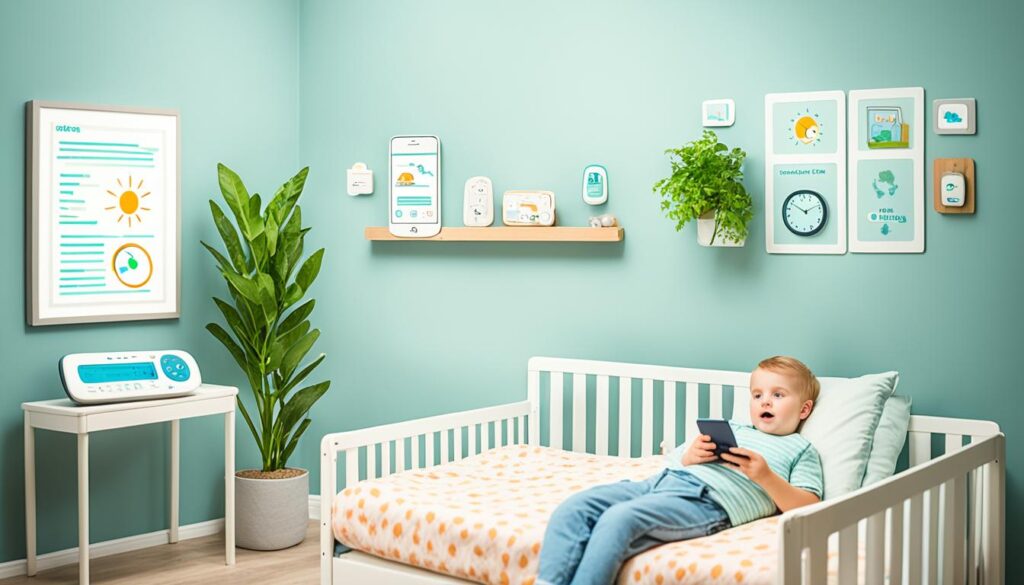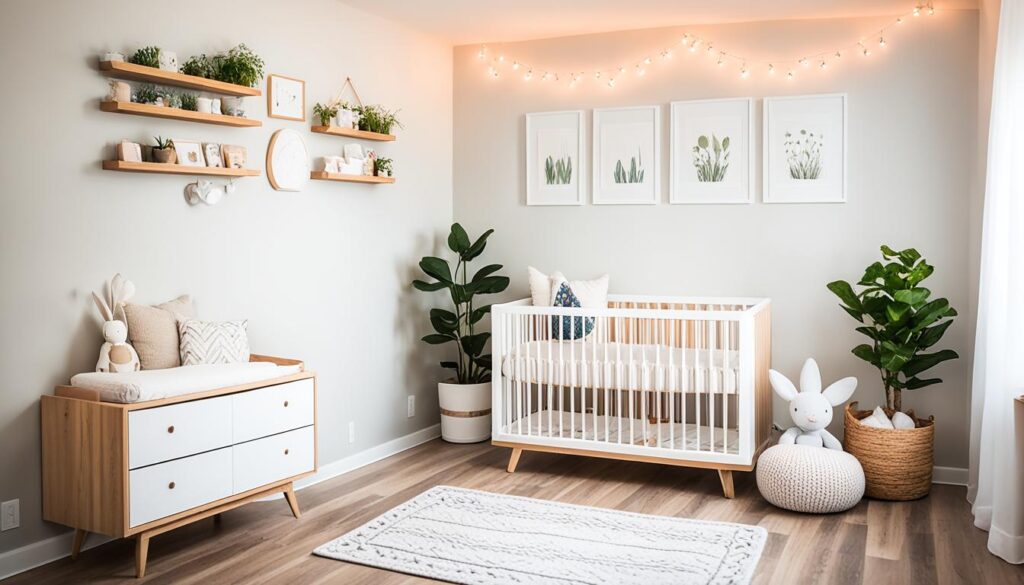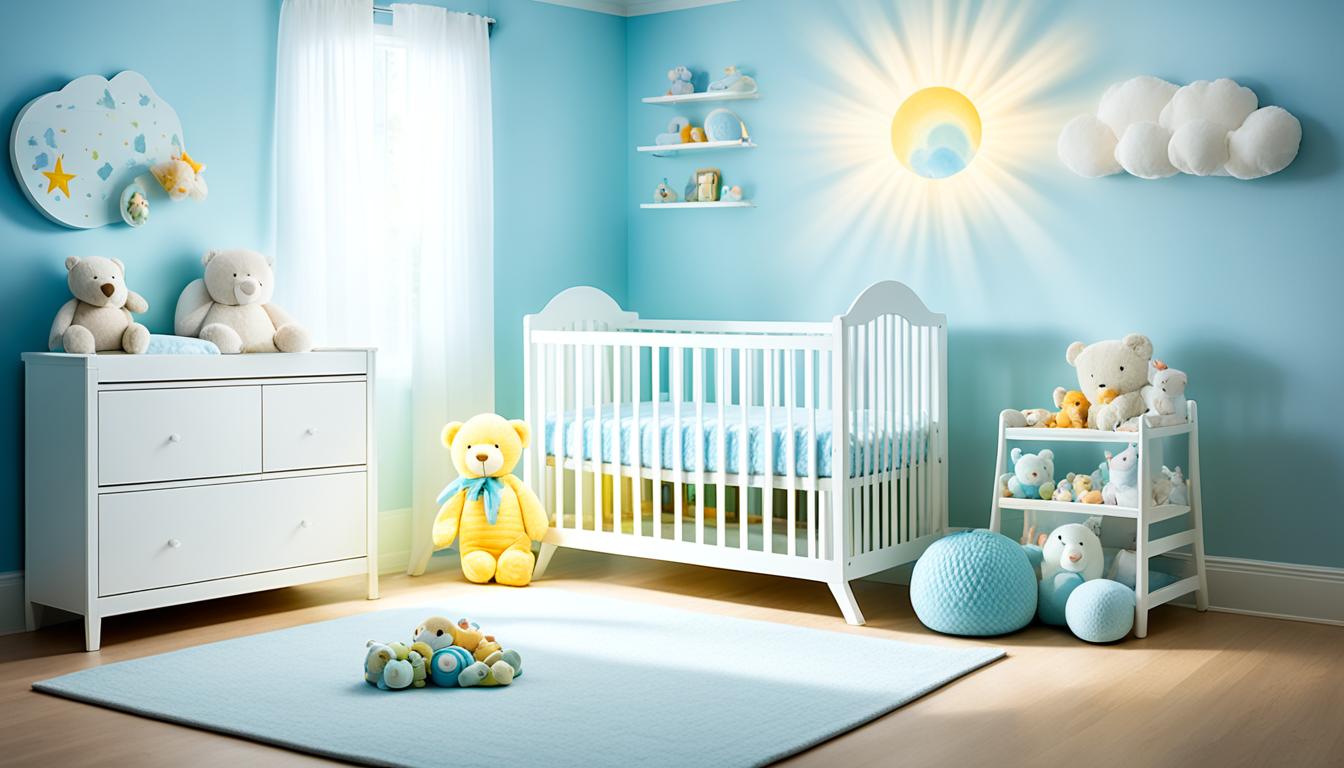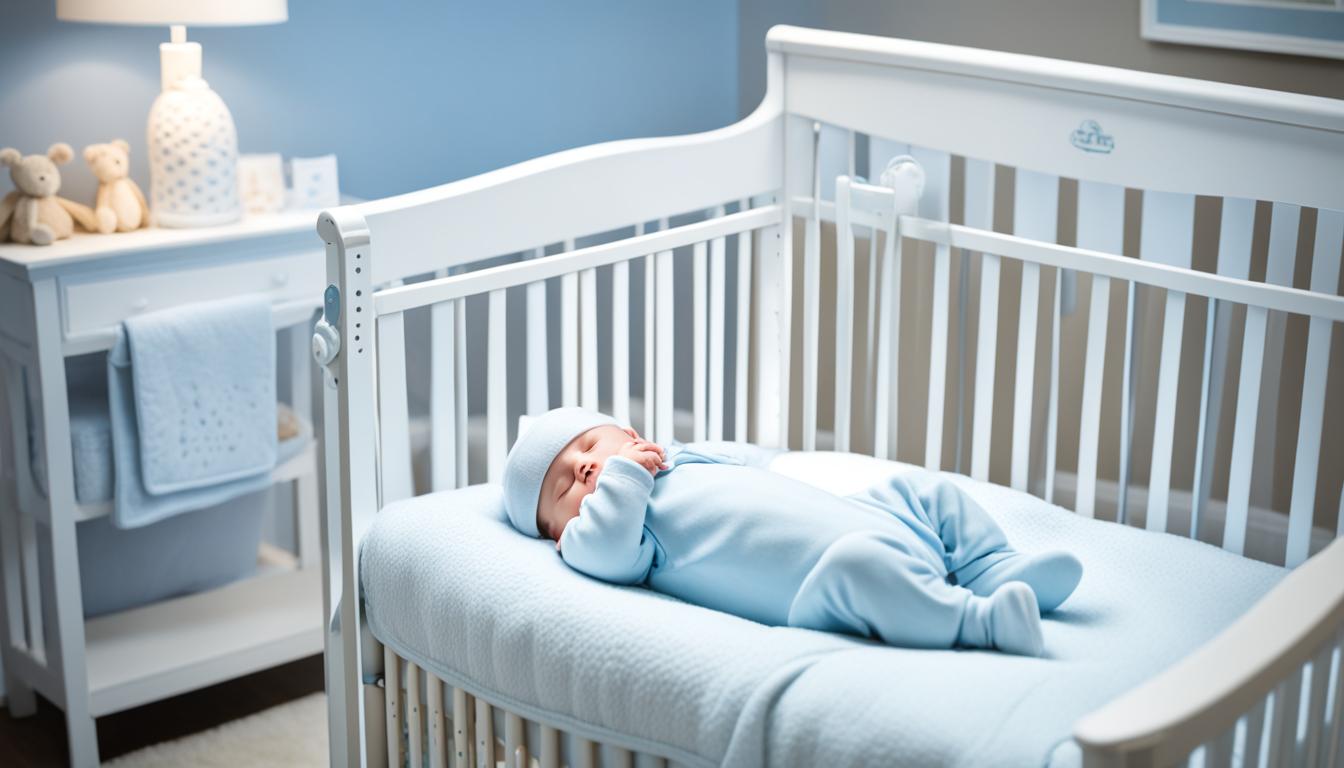Disclosure: This Post Contains Affiliate Links; We earn a commission on purchases.
EMFs, or electromagnetic fields, are a growing concern in the wellness and non-toxic communities, especially when it comes to the health of our little ones. The adverse effects of EMFs on children, who are more vulnerable due to their physiological differences, cannot be ignored. From disrupting brain development to contributing to chronic health conditions, EMFs can pose real risks. In fact, the World Health Organization even classifies them as a possible carcinogen.
In this article, we will explore practical solutions for reducing EMF exposure in your baby’s nursery, creating a safer environment for their sleep and growth. By implementing these tips, you can take proactive steps to minimize the potential risks associated with EMFs and provide your baby with the best possible start in life.
Key Takeaways:
- Reduce EMF exposure in your baby’s nursery to create a safer environment for their well-being
- Understand the potential risks of EMFs on children’s health, such as disruptions in brain development
- Minimize EMF sources in the nursery, including baby monitors and unnecessary electronics
- Consider using EMF shielding solutions like paints or bed canopies to block RF/EMFs
- Be mindful of EMF exposure from baby monitors and explore safer alternatives
Understanding the Impact of EMFs on Children’s Health
EMFs, or electromagnetic fields, can have significant effects on the health of children. Research suggests that exposure to EMFs can lead to various health issues, including sleep disturbances, fatigue, headaches, ADHD-like behavior, and memory changes.
Furthermore, EMFs can disrupt the endocrine system, causing disruptions in reproductive and thyroid hormones, melatonin levels, and adrenal hormones. This interference with hormonal balance can have long-term implications for a child’s development and well-being.
Studies have also shown that EMFs can cause oxidative stress and DNA alterations, potentially leading to chronic conditions in children. Additionally, there is evidence to suggest that EMFs may increase the risk of neurodegenerative diseases and contribute to infertility through increased levels of apoptosis.
It is important for parents to understand these potential effects and take steps to reduce EMF exposure in their child’s environment, particularly in places like the nursery where they spend a significant amount of time.
By reducing EMF exposure and creating a low EMF environment, parents can help protect their children from the potential risks associated with EMFs and promote their overall health and well-being.
Decreasing EMFs in the Bedroom for Restful Sleep
The bedroom is a sanctuary for rest and rejuvenation, making it crucial to create an EMF-free sleeping environment. By taking simple steps to reduce EMF exposure in the bedroom, you can promote better sleep and overall well-being. Here are some effective strategies:
Unplugging WIFI at night
One of the easiest ways to minimize EMFs in the bedroom is by unplugging WIFI routers at night. WIFI emits RF radiation, which can disrupt sleep patterns and negatively impact health. By turning off your WIFI before going to bed, you can create a low EMF environment conducive to restful sleep.
Removing electrical equipment in the bedroom
Electrical equipment such as smartphones, laptops, and electronic devices emit EMFs even when not in use. It’s best to keep these devices out of the bedroom altogether or at least at a significant distance from your bed. This simple step can significantly reduce your exposure to EMFs while you sleep.
Keeping bed away from smart meters or live wires
Smart meters and live wires are common sources of high EMF levels. To minimize your exposure, ensure that your bed is located far away from any smart meters or live wires in your bedroom. By creating distance between yourself and these EMF sources, you can create a safer sleeping environment.
EMF shielding solutions
In addition to the above steps, you can explore EMF shielding solutions to further reduce EMF exposure in the bedroom. EMF shielding paint and bed canopies are effective options for blocking RF/EMF from outside sources. These solutions create a barrier that helps to minimize EMF penetration into your bedroom, allowing for a more restful sleep.
By implementing these strategies, you can create a bedroom environment that promotes restful sleep and reduces your exposure to EMFs. Take control of your sleep environment and prioritize your well-being.

| Strategies for Decreasing EMFs in the Bedroom | Effectiveness |
|---|---|
| Unplugging WIFI at night | High |
| Removing electrical equipment in the bedroom | Medium |
| Keeping bed away from smart meters or live wires | High |
| Using EMF shielding solutions | High |
Creating a Low EMF Nursery: Practical Tips
When it comes to creating a safe and healthy environment for your baby, minimizing electromagnetic field (EMF) exposure is essential. The nursery is an area where EMF sources can be found, so taking steps to create a low EMF nursery is crucial for your baby’s well-being. By implementing the following practical tips, you can reduce EMF exposure and provide a safer space for your little one:
- Opt for Safer Alternatives to Baby Monitors: Baby monitors can be a significant source of EMF radiation in the nursery. Consider using audio-only analog baby monitors, as they emit lower levels of radiofrequency (RF) radiation compared to digital baby monitors with video capabilities.
- Limit the Use of EMF-Emitting Devices: Evaluate the necessity of EMF-emitting devices in the nursery and aim to reduce their usage. Use battery-operated options whenever possible, as they emit fewer EMFs compared to devices that are constantly plugged into electrical outlets.
- Avoid Unnecessary Electronics: Minimize the presence of unnecessary electronics in the nursery to further reduce EMF exposure. Instead, create a more old-school environment with fewer electronic gadgets and opt for simpler, non-EMF emitting toys and decorations.
By following these tips, you can create a low EMF nursery and provide your baby with a safer and healthier sleeping environment. Remember, every effort counts in minimizing EMF exposure for your little one’s well-being.

Safer Alternatives to Baby Monitors
In the quest for a low EMF nursery, it’s important to explore safer alternatives to traditional baby monitors. Here are a few options to consider:
| Baby Monitor Type | Features | EMF Emission |
|---|---|---|
| Audio-Only Analog Baby Monitors | Transmits sound only | Lower RF radiation compared to digital video monitors |
| Wired Baby Monitors | Video and audio capabilities | Minimal RF radiation as they don’t use wireless signals |
| Smartphone Apps with Airplane Mode | Utilizes existing smartphone and Wi-Fi connection in airplane mode | Minimal RF radiation |
The Risks of EMF Exposure from Baby Monitors
Baby monitors are a common source of RF radiation in a baby’s nursery. While the long-term effects of EMF exposure on developing brains are still being studied, it is known that a child’s brain is more vulnerable to EMFs due to its thin skull and ongoing development.
This makes it crucial to be aware of the risks associated with EMF exposure from baby monitors and consider safer alternatives that emit lower levels of EMFs, such as wired baby monitors or those without wifi connectivity.
Tips for Reducing EMF Exposure from Baby Monitors
If you’re using baby monitors in your nursery, there are several strategies you can implement to minimize your baby’s exposure to electromagnetic fields (EMFs). By following these helpful tips, you can create a safer environment for your little one:
1. Distance from Baby Monitors
Keep the baby monitor at a distance from your baby’s crib or sleeping area. The intensity of RF fields emitted by baby monitors diminishes as you increase the distance. By placing the monitor farther away, you can reduce your baby’s exposure to EMFs.
2. Turning Off Baby Monitors When Not Needed
Remember to turn off the baby monitor when you don’t need it, especially during nap times or when you’re in the same room as your baby. This simple step can help reduce ongoing EMF exposure.
3. Using a Tin Foil Barrier
Consider using a tin foil barrier between the camera device and your baby. This can act as a shield, reducing the amount of EMFs reaching your baby. Create a small pinhole in the foil for the camera lens to ensure visibility while minimizing exposure.
4. Low EMF Baby Monitor Options
Opt for baby monitors that have lower EMF emissions. Look for models that prioritize low radiation levels and have been tested for their EMF emissions. These low EMF baby monitors provide a safer option for monitoring your baby while minimizing exposure to harmful electromagnetic fields.
By implementing these tips, you can reduce your baby’s exposure to EMFs from baby monitors and create a safer environment for their sleep and growth.
Additional Tips for Reducing EMF Exposure in the Nursery
Aside from baby monitors, there are other sources of EMF exposure in the nursery that parents should be mindful of. By implementing a few simple practices, you can significantly reduce your child’s exposure to EMFs and create a safer environment. Here are some additional tips:
- Distance between child and EMF sources: Keep your child at a safe distance from EMF-emitting devices. The farther away they are, the lower their exposure. Encourage play areas and sleep spaces to be located away from devices like wifi routers, cordless phones, and smart toys.
- Airplane mode for devices: When using electronic devices in the nursery, such as tablets or smartphones, switch them to airplane mode. This disables wifi and bluetooth connectivity, reducing the emission of EMFs. The best practice is to use devices without any wireless connectivity whenever possible.
- Avoiding unnecessary EMF sources: It’s essential to critically assess the use of devices in the nursery. Limit the presence of wifi routers, cordless phones, and smart toys that emit EMFs. Instead, opt for simpler, non-electronic alternatives that encourage creativity and imagination.
To summarize, maintaining a safe distance between your child and EMF sources, using airplane mode for devices, and avoiding unnecessary EMF sources in the nursery are effective ways to reduce your child’s exposure to electromagnetic fields. By implementing these tips, you can create a healthier and safer environment for your little one’s development.
Conclusion
Reducing EMF exposure in your baby’s nursery is essential for creating a safer environment that promotes their sleep and growth. By understanding the potential risks of EMFs and implementing practical solutions, you can protect your child from unnecessary EMF exposure and ensure their overall well-being.
One key step is to decrease EMF levels in the bedroom, where your baby spends a significant amount of time sleeping. Unplugging the WIFI at night and removing unnecessary electrical equipment are simple yet effective ways to minimize EMFs. Additionally, keeping the bed away from smart meters or live wires and utilizing EMF shielding solutions can provide further protection.
Creating a low EMF nursery is also crucial. Baby monitors, a common source of RF radiation, should be chosen carefully, with safer alternatives that emit lower levels of EMFs being preferred. Limiting the use of EMF-emitting devices and avoiding unnecessary electronics can further reduce EMF exposure in the nursery. Additionally, being mindful of other sources of EMF exposure, such as wifi routers and smart toys, can contribute to a safer environment for your baby.
By implementing these strategies and taking proactive measures to reduce EMF exposure, you can provide your baby with an environment that supports EMF-free sleep and supports their health and growth. Protecting children from EMF exposure is a responsible choice that every parent should consider for the well-being of their little ones.
Source Links
- https://www.kithandkinwellness.com/blog-posts/reduce-emf-exposure
- https://emfguide.com/the-definitive-guide-to-low-emf-nurseries-and-childrens-rooms/
- https://www.ruanliving.com/blog/emf-exposures-from-baby-monitors-solutions

Subscribe to Our Newsletter










